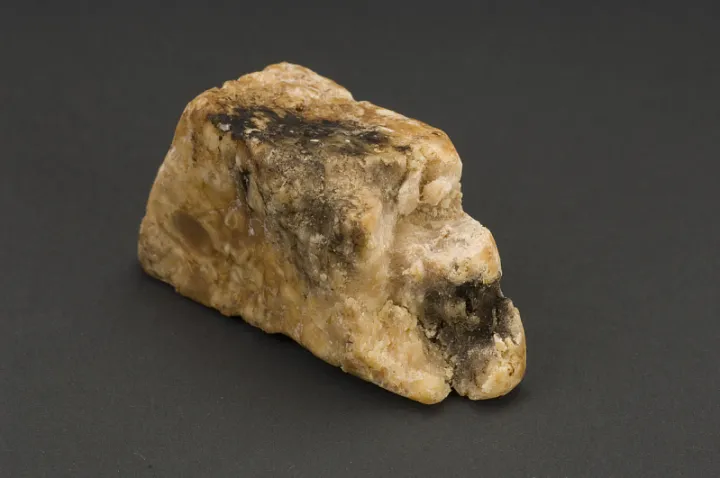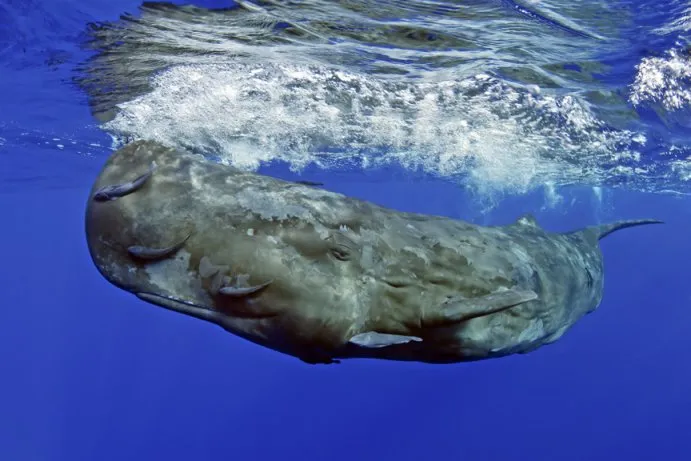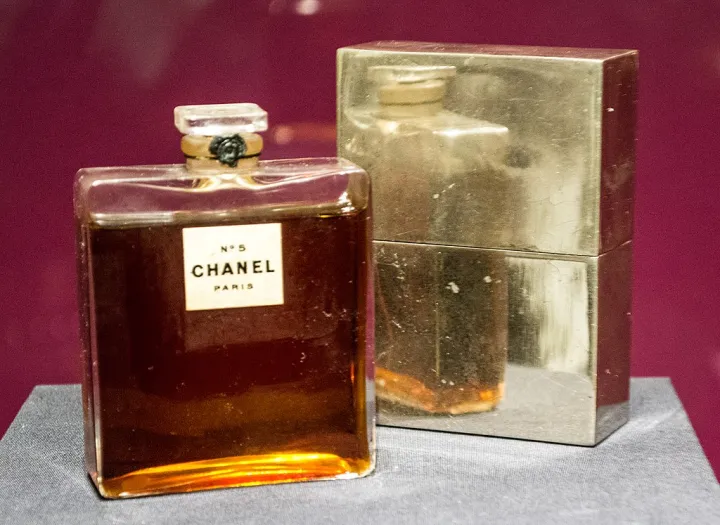The Mystery of Ambergris

One of the most sought after and mysterious natural substances throughout history comes from the bowels of a sperm whale. For over a thousand years, ambergris, a waxy substance that washes ashore on beaches around the world, has been sought after for its unique scent. Described as musky with notes of tobacco, sandalwood, and ocean, some of the most famous and notable perfumes relied upon its indescribable yet desirable smell. The perfume makers paid handsomely for it. Until recently, the origin of ambergris was a mystery, with guesses from fish liver, fruit from the sea, petrified lynx urine, to the truly far-fetched— solidified dragon spittle. So, what exactly is ambergris?
Ambergris is formed in the bowels of sperm whales. Sperm whales are particularly fond of squid, and though the squid’s body is soft, their mouth contains a hard beak that is not readily digestible. The whales must expel the hard beaks by vomiting them up. However, in some instances the beaks pass from the stomachs (sperm whales have four) into the whale’s intestine. When this happens a waxy substance forms around the beaks to protect the fragile intestine walls. Though it has yet to be proven, scientists believe that either the waxy ball remains inside the whale until it dies, or the ball grows so big that it ruptures the digestive tract and kills the whale. Free floating in the ocean, this waxy substance ages over time and its aroma matures from smelling faintly of excrement to the desired smell of ambergris.
For centuries the origin of ambergris captivated the imaginations of people around the world. Some guessed it to be dried sea foam or foam of seals, while to others it was a fungus that grew at the bottom of the sea. Some claimed it to be a rare clay. Or, perhaps, hardened bird poop from a special bird in Madagascar. A waxy substance, ambergris was believed to be honeycomb that melted off the shore and molded by the sea.
The first indication ambergris came from whales was during the height of whaling in New England during the 1600s. Sperm whales were sought after for their oil and upon harvesting the whales whalers soon discovered that the carcass contained the waxy substance. Initial beliefs that the substance was created by the bladder soon gave way to the idea that it came from the digestive tract. Whalers soon knew where to look for the prized substance, and it was in the rear end of the whale. Questions about the nature of its creation persisted until the early 1900s. Today, it is generally accepted that ambergris forms around squid beaks in the bowels of sperm whales.
Despite its origins, for over a thousand years people of various cultures have sought after ambergris for its unique properties. One of the earliest known uses of ambergris was in ancient Egypt, where it was burned as incense. The Egyptians believed that the sweet, earthy scent of ambergris could purify the air and ward off evil spirits. In other Arabic regions people used it as a medicinal remedy for digestive issues, heart conditions, and as a general tonic to optimize health. Later during the Black Death in the 14th century, people in Europe carried balls of ambergris, called pomanders, to protect themselves from the plague. They believed that the pleasant smell of ambergris could counteract the “bad air” that caused the disease.
The unique taste and aroma of ambergris made it a popular ingredient in luxury dishes and beverages like in Turkish coffee, Persian sherbet, hot chocolate, upscale cocktails, punch, the first recipes of ice cream and a drink called posset, a popular hot beverage in medieval Europe made from milk curdled with ale or wine, often spiced and sweetened. It is said that in 17th-century Britain King Charles II favored his eggs seasoned with ambergris and the famous lover Casanova was known to add ambergris to his chocolate mousse, believing it to have aphrodisiac properties.
The most famous use of ambergris, however, is in perfume. Its ability to fix and enhance other scents made it a prized ingredient in many perfumes including some of the world’s most famous perfumes, like Chanel No. 5 and Shalimer by Guerlain. Perfumes rely upon the compound ambrein, an alcohol within ambergris that is likely responsible for its unique scent and helps stabilize other scents. Even today, some high-end perfumes still use ambergris, although synthetic alternatives are more common. Whaling is now illegal, and selling ambergris is illegal in many countries. Finding ambergris washed ashore is extremely rare, making it almost impossible to acquire a piece legally.
Despite the perfume industry’s move away from ambergris use, it remains a rare and valuable commodity, treasured for its unique properties and fascinating history. Perhaps, Herman Melville sums up the allure of ambergris best in his novel Moby Dick, "Who would think, then, that such fine ladies and gentlemen should regale themselves with an essence found in the inglorious bowels of a sick whale! Yet so it is."




